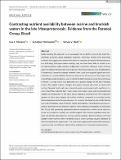Files in this item
Contrasting nutrient availability between marine and brackish waters in the late Mesoproterozoic : evidence from the Paranoá Group, Brazil
Item metadata
| dc.contributor.author | Stueeken, Eva Elisabeth | |
| dc.contributor.author | Viehmann, Sebastian | |
| dc.contributor.author | Hohl, Simon | |
| dc.date.accessioned | 2021-10-18T12:30:01Z | |
| dc.date.available | 2021-10-18T12:30:01Z | |
| dc.date.issued | 2022-03-01 | |
| dc.identifier | 276252065 | |
| dc.identifier | 61e86731-c983-40f7-9146-ef47cbd91cd3 | |
| dc.identifier | 85117138203 | |
| dc.identifier | 000708005500001 | |
| dc.identifier.citation | Stueeken , E E , Viehmann , S & Hohl , S 2022 , ' Contrasting nutrient availability between marine and brackish waters in the late Mesoproterozoic : evidence from the Paranoá Group, Brazil ' , Geobiology , vol. 20 , no. 2 , pp. 159-174 . https://doi.org/10.1111/gbi.12478 | en |
| dc.identifier.issn | 1472-4677 | |
| dc.identifier.other | ORCID: /0000-0001-6861-2490/work/101958957 | |
| dc.identifier.uri | https://hdl.handle.net/10023/24152 | |
| dc.description | Funding: Natural Environment Research Council (Grant Number(s): NE/V010824/1). | en |
| dc.description.abstract | Understanding the delayed rise of eukaryotic life on Earth is one of the most fundamental questions about biological evolution. Numerous studies have presented evidence for oxygen and nutrient limitations in seawater during the Mesoproterozoic era, indicating that open marine settings may not have been able to sustain a eukaryotic biosphere with complex, multicellular organisms. However, many of these data sets represent restricted marine basins, which may bias our view of habitability. Furthermore, it remains untested whether rivers could have supplied significant nutrient fluxes to coastal habitats. To better characterize the sources of the major nutrients nitrogen and phosphorus, we turned to the late Mesoproterozoic Paranoá Group in Brazil (~1.1 Ga), which was deposited on a passive margin of the São Francisco craton. We present carbon, nitrogen and sulphur isotope data from an open shelf setting (Fazenda Funil) and from a brackish-water environment with significant riverine input (São Gabriel). Our results show that waters were well-oxygenated and nitrate was bioavailable in the open ocean setting at Fazenda Funil; the redoxcline appears to have been deeper and further offshore compared to restricted marine basins elsewhere in the Mesoproterozoic. In contrast, the brackish site at São Gabriel received only limited input of marine nitrate and sulphate. Nevertheless, previous reports of acritarchs reveal that this brackish-water setting was habitable to eukaryotic life. Paired with previously published cadmium isotope data, which can be used as a proxy for phosphorus cycling, our results suggest that complex organisms were perhaps not strictly dependent on marine nutrient supplies. Riverine influxes of P and possibly other nutrients likely rendered coastal waters perhaps equally habitable to the Mesoproterozoic open ocean. This conclusion supports the notion that eukaryotic organisms may have thrived in brackish or perhaps even freshwater environments. | |
| dc.format.extent | 16 | |
| dc.format.extent | 1822348 | |
| dc.language.iso | eng | |
| dc.relation.ispartof | Geobiology | en |
| dc.subject | Continental versus marine environments | en |
| dc.subject | Eukaryotes | en |
| dc.subject | Mesoproterozoic | en |
| dc.subject | Nutrients | en |
| dc.subject | QE Geology | en |
| dc.subject | QH301 Biology | en |
| dc.subject | DAS | en |
| dc.subject | SDG 14 - Life Below Water | en |
| dc.subject | MCC | en |
| dc.subject.lcc | QE | en |
| dc.subject.lcc | QH301 | en |
| dc.title | Contrasting nutrient availability between marine and brackish waters in the late Mesoproterozoic : evidence from the Paranoá Group, Brazil | en |
| dc.type | Journal article | en |
| dc.contributor.sponsor | NERC | en |
| dc.contributor.institution | University of St Andrews. School of Earth & Environmental Sciences | en |
| dc.contributor.institution | University of St Andrews. St Andrews Centre for Exoplanet Science | en |
| dc.identifier.doi | https://doi.org/10.1111/gbi.12478 | |
| dc.description.status | Peer reviewed | en |
| dc.identifier.grantnumber | NE/V010824/1 | en |
This item appears in the following Collection(s)
Items in the St Andrews Research Repository are protected by copyright, with all rights reserved, unless otherwise indicated.

